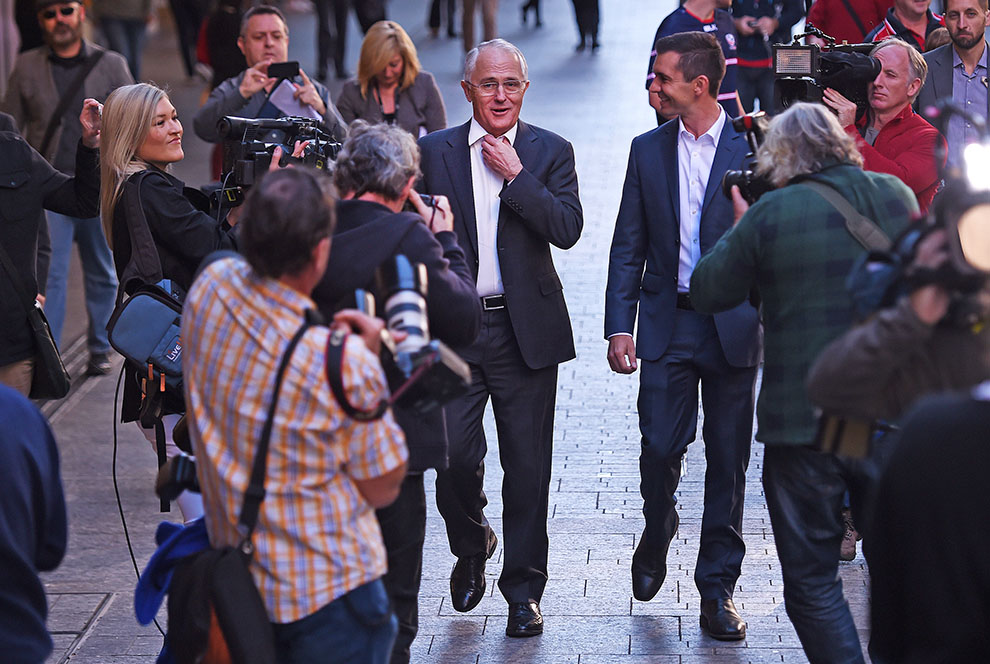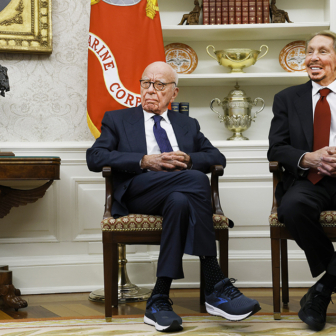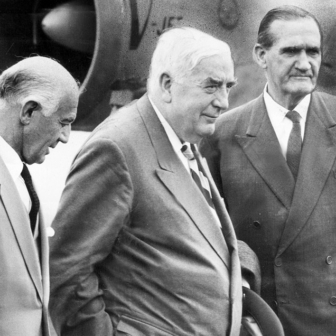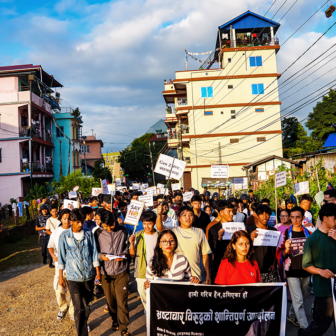The first section of this article is no longer current: Tim Colebatch’s subsequent election update appears here.
The Coalition, we’re told, is steaming towards a majority. Day after day, one by one (or two by two), Antony Green has shifted seats out of his “in doubt” column and into the Coalition camp. It feels like momentum is sweeping Malcolm Turnbull towards the majority he predicted on Saturday night.
Whoa, boy. No, it isn’t. What we are seeing is a one-off surge in the Coalition vote because the Electoral Commission is currently counting the most pro-Coalition votes of all: postal votes.
In some seats, the surge has been big enough to put the Coalition’s lead beyond reach. Last night Antony moved Chisholm and Dunkley into the Coalition’s camp, and today I would move Gilmore there as well.
The Coalition now has pretty well locked in seventy-three of the 150 seats, to Labor’s sixty-six. There will be five crossbenchers, and six seats are still in doubt: the Queensland seats of Capricornia (Rockhampton and heading north), Flynn (Gladstone and heading west), Forde (Logan in western Brisbane) and Herbert (Townsville); Hindmarsh, in the suburbs around Adelaide airport; and Cowan, in north suburban Perth.
To win majority government, the Coalition needs to win three of these six seats. But so far it is leading only in Forde. And while all of them look better now for the Coalition than they did two days ago, that’s because of those postal votes.
In Hindmarsh, for example, it has counted almost 6000 of them, and they have reduced Labor’s lead to 0.09 per cent. In the Queensland seats, the commission is only a quarter or a third of the way through the postals, but that explains why the Coalition is suddenly doing much better.
The 2013 count shows what I mean. The Coalition won 45.4 per cent of the votes we cast at polling booths but 50.8 per cent of all postal votes, of which there were 1.1 million. That lifted its share of the vote temporarily to 45.9 per cent.
But what happened then? Three other categories were (and are) yet to be counted: absentee votes, pre-poll votes cast in other electorates, and a small number of “provisional” votes by people who weren’t on the roll but can prove they should have been. There were 1.1 million of all these votes in 2013, but the Coalition got only 41.7 per cent of them.
Postal votes tend to come from older voters and those who live far from polling booths; both groups tend to be Coalition voters. Absentee and pre-poll votes come from people travelling on election day; they tend to be younger, and more likely to vote Labor or Greens. The commission hasn’t counted any of their votes yet.
Last time, the Coalition ended up with 45.55 per cent of the primary vote. At this stage of the count, its vote is now close to peaking. The surge might last another day or two, but then it will reverse, as officials start counting the absentee and pre-poll votes. We are getting close to what the final results will look like.
In Hindmarsh, for example, two-thirds of the postals have been counted, and Labor’s Steve Georganas, its former MP, still holds a 151-vote lead over Matt Williams, who defeated him in 2013. That suggests to me that Georganas will probably hold the seat once the absentee/pre-poll votes are counted.
Flynn, in central Queensland, is the opposite case. On election night, Labor appeared to have won it clearly. In 2013, an extraordinary haul of postal votes favoured the Coalition – it won 69 per cent of postals though just 54 per cent at the ballot boxes – but I for one assumed that was a freak result.
I was wrong: it’s happened again. The Coalition this time won just 48 per cent of votes at Flynn’s polling booths, but so far has won 64 per cent of its postal votes. I would still rather be in Labor’s shoes, but Flynn is now too close to call.
At 2 pm on Thursday, Labor led by just eight votes in Hindmarsh, 0.40 per cent in Herbert, 0.49 per cent in Capricornia, 0.52 per cent in Cowan, and 0.83 per cent in Flynn. The Coalition leads by 0.32 per cent in Forde. I doubt that any of these seats will be decided today, and it may be that it will still be unclear for a few days yet whether the Coalition will win majority government.
What is clear is that there will be a Coalition government under Malcolm Turnbull, unless the Coalition’s right-wing rebels can persuade colleagues to join them in an act of mass hara-kiri.
Victoria was the only state where Labor lost a seat, and the swing to Labor was by far the lowest of any state: 1.5 per cent, barely a third of the 4.4 per cent Labor won in the rest of Australia. Why?
Was that stark difference due to premier Daniel Andrews’s spectacular mishandling of the Country Fire Authority dispute, as many believe? If so, how do we explain the fact that the only Labor seat to fall was middle-suburban Chisholm, remote from any threat of bushfires?
Maybe we weren’t looking in the right places. Maybe Labor did lose a seat over the CFA dispute.
It wasn’t Chisholm, but La Trobe, in the southern Dandenongs, their suburban foothills, and the outer ’burbs along the Princes Highway. As of last night, the Coalition had a 2000-vote lead in La Trobe; maybe it’ll be 2500 by the time the count ends, so that’s a margin of just 1250 votes that went against Labor out of 100,000.
On polling day, when the polling booths in La Trobe on average swung to Labor by 2.5 per cent, ten booths swung the other way: Belgrave South, Cockatoo, Ferntree Gully, to name a few. Another eight booths swung only slightly to Labor: they included Emerald, Gembrook and Olinda. They were the polling booths in the Dandenongs.
By contrast, the big booths in the Princes Highway suburbs recorded swings to Labor as large as 7.5 per cent at Timbarra (Berwick) and 6.1 per cent at Narre Warren. Had the Dandenongs not been part of the electorate, Labor certainly would have won it.
It is fair to assume that the CFA dispute was the main reason why people in the Dandenongs voted differently from their southern neighbours. It’s probably the reason Labor lost the seat.
You can see the same pattern in other electorates. Just north in Casey, Labor won swings in suburban Croydon and Lilydale, but higher up the mountain, Montrose and Mount Dandenong swung to the Liberals. In McEwen, where the Liberals suffered an 8 per cent swing against them after choosing a dud candidate, even he won a swing to the party in areas ravaged by the 2009 bushfires, such as Arthurs Creek and St Andrews.
Marysville, epicentre of that bushfire, even took it out on independent Cathy McGowan. In Bendigo, the suburbs swung to Labor; outside town, fifteen polling booths went the other way, including heavily timbered areas such as Mount Macedon and Tarnagulla. And in Corangamite, the thirteen booths that swung to the Liberals included the beautiful but bushfire-prone Anglesea, Aireys Inlet and Lorne.
The Liberals’ Sarah Henderson probably would have won a second term in Corangamite anyway; her majority was barely dented on Saturday. Chisholm would probably have fallen anyway: Labor sources say it was a Liberal seat on voting at the 2014 state election, and Anna Burke’s personal vote was probably one of the two things that kept it in Labor’s camp in 2013.
Pardon me for being politically incorrect, but to me it was courageous for Labor to stand a blind man, Tony Clark, as its candidate in a marginal seat like Deakin. I suspect suburban Melbourne still harbours a residue of old-fashioned distrust of people who are different. It hurt the Liberals’ John Nguyen, a Vietnamese Australian, in Chisholm in 2013, and it hurt Tony Clark in Deakin in 2016.
But La Trobe is a seat that Labor could have won, were it not for the CFA dispute. The Andrews government must bear the blame.
Now to Tasmania, where a small sample gave some tantalising results. For a brief period on Wednesday, state electoral officials distributed about 1000 Senate votes exactly as the voter intended – rather than follow the rule book, which tells them to put aside until later in the count all votes cast below the line, in which the voters have made their own choice of candidates rather than following the party’s.
In Tasmania, below the line votes matter. First, Labor dumped feisty left-wing senator Lisa Singh to the unwinnable sixth spot on its ticket. The senator and her fans responded by flooding the island with “Vote 1 Singh” posters to urge voters to buck the ticket and vote for her.
Then party boss Eric Abetz, not a man who believes in a broad church, dumped tourism minister Richard Colbeck to the vulnerable fifth spot on the party ticket as punishment for Colbeck voting for Malcolm Turnbull, supporting gay marriage – and replacing Abetz as the senior Tasmanian in the ministry. Amazingly, the federal Liberal Party didn’t intervene. Colbeck, too, responded by asking supporters to vote below the line and put him first.
Tasmanians are good at doing that. Their state elections follow a Senate-type system, but with no above-the-line voting; they pick the candidates they want. Even in federal elections under the old system, up to 20 per cent of Tasmanians chose their own, putting a number in every square on the ballot paper rather than just a 1 in the party box.
In the sample posted on Wednesday on the election results website, 22 per cent of Labor voters had voted below the line – and just over half of them voted for Singh. Similarly, 22 per cent of Liberal voters voted below the line – and just over half voted for Colbeck.
If those samples are representative of the votes for their parties, both of them would end up with personal votes of roughly half a quota. That might just be enough for them to hold on to their seats, at the expense of a more pliant colleague. •




